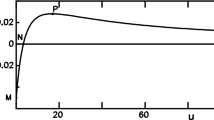Abstract
A perturbation theory is constructed within the framework of a linear version of the variable-phase approach, with the aim of making a complete study of the problem of scattering by a superposition of the Coulomb potential and the potential V(x) which decrease faster than the centrifugal potential. As a zero approximation of the theory for regular and irregular solutions to this problem, for normalization factors, scattering phase and amplitude, use is made of the corresponding functions calculated for the potential V(x) cut off at a certain point x=b. All subsequent approximations are determined analytically by the iteration method. Perturbation theory is applied to investigate the asymptotics of the partial waves of scattering phases and amplitudes in the low-energy limit and in the limit of large angular momenta.
Similar content being viewed by others
References
L. D. Landau and E. M. Lifshitz,Quantum Mechanics [in Russian], Nauka, Moscow (1974).
A. Messia,Quantum Mechanics [in Russian], vol. 2, Nauka, Moscow (1979).
J. Taylor,Scattering Theory [Russian translation], Mir, Moscow (1975).
M. Reed and B. Simon,Methods of Modern Mathematical Physics, vol. 3, Scattering Theory [Russian translation], Mir, Moscow (1982).
Yu. L. Mentkovskij,Particles in a Nuclear-Coulomb Field [in Russian], Energoatomizdat, Moscow (1982).
R. Peierls,Surprises in Theoretical Physics, Princeton University Press, Princeton, New Jersey (1979).
F. Kalodzhero,Method of Phase Functions in the Theory of Potential Scattering [Russian translation], Mir, Moscow (1972).
V. V. Babikov,Method of Phase Functions in Quantum Mechanics [in Russian], Nauka, Moscow (1976).
C. K. Au et. al.,Phys. Lett. A.,164, 23–27 (1992).
J. Sansone,Ordinary Differential Equations [Russian translation], Vol. 1, IL, Moscow (1953).
A. N. Kolmogorov and S. V. Fomin,Elements of the Theory of Functions and Functional Analysis [in Russian], Nauka, Moscow (1976).
M. Abramovits and I. A. Stigan,Handbook on Special Functions [in Russian], Nauka, Moscow (1979).
V. Volterra,Theory of Functionals, Integral and Integro-Differential Equations [in Russian], Nauka, Moscow (1982).
S. Klarsfeld,Nuovo Cimento,A 43, 3869–3886 (1966).
M. V. Fedoryuk,Asymptotic Methods for Linear Differential Equations [in Russian], Nauka, Moscow (1983).
A. Martin,Nuovo Cimento,31, 1229–1243 (1964).
V. V. Pupyshev and O. P. Solovtsova,Yad. Fiz.,47, 60–64 (1988).
V. V. Pupyshev and O. P. Solovtsova,IJMP,A7, 2713–2739 (1992).
V. V. Pupyshev,How to build analogues of the Bessel-Clifford expansions for the sum of the repulsive Coulomb potential and the central potential decreasing more rapidly than the centrifugal one, Preprint E4-92-213, JINR, Dubna (1992).
R. O. Berger and L. Spruch,Phys. Rev.,B138, 1106–1115 (1965).
Author information
Authors and Affiliations
Additional information
Translated from Teoreticheskaya i Matematicheskaya Fizika, Vol. 105, No. 1, pp. 29–45, October, 1995.
Rights and permissions
About this article
Cite this article
Pupyshev, V.V. Perturbation theory for the one-dimensional Schrödinger scattering problem. Theor Math Phys 105, 1210–1223 (1995). https://doi.org/10.1007/BF02067490
Received:
Revised:
Issue Date:
DOI: https://doi.org/10.1007/BF02067490



